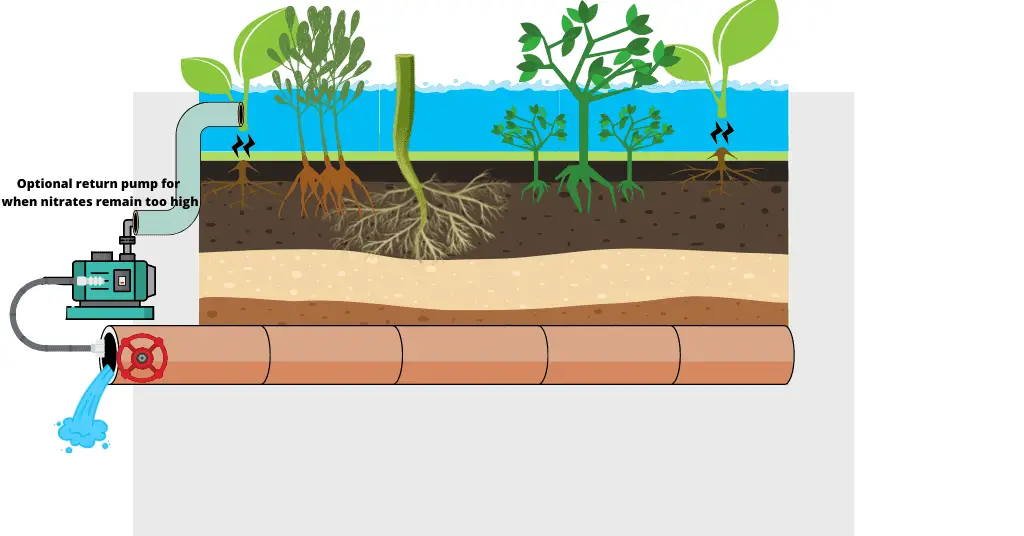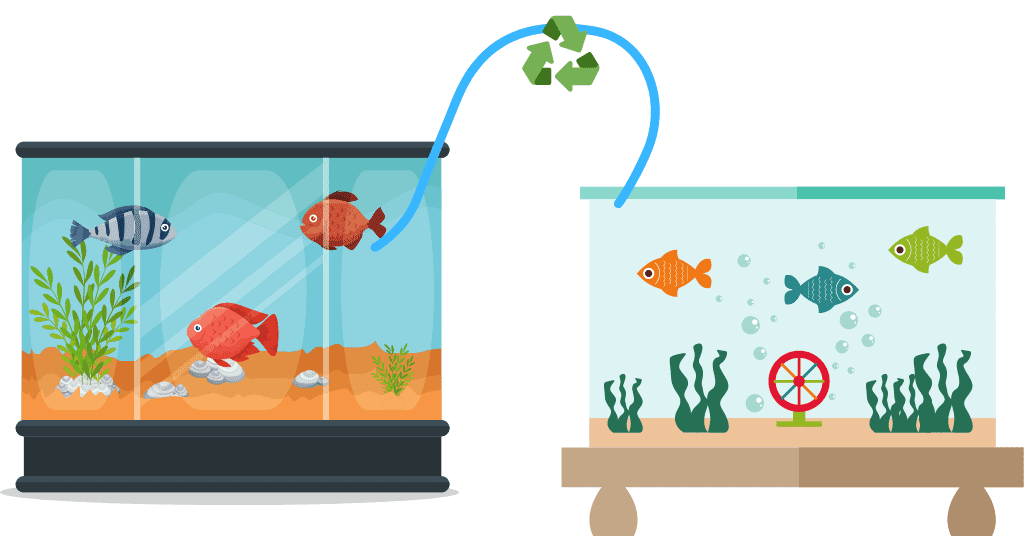Last Updated on July 14, 2022 by cmoarz
There are a lot of reasons why you might want to recycle your aquarium water. You may live in a place that has limited access to water, or your available water isn’t suitable for an aquarium because of various added chemicals.
Whatever the reason, you might be wondering can you recycle aquarium water for reuse in an aquarium. The answer is yes! But it’s a bit complicated.

Reusing aquarium water in another fish tank
Table of Contents
Old aquarium water usually has a few problems when it comes out of the tank. The problems are the reasons we even change our water in the first place, Nitrites.
Used tank water is usually high in various waste byproducts and nitrates. These need to be addressed before you add the water to another tank.
Most common filters that are used to clean water will remove most wastes, but they don’t remove nitrates (or nitrites or ammonia for that matter). For the record, Boiling water doesn’t remove them either!
This is where thing tends to get more complicated. You can’t just take old water, put it in a new filter and expect it to be clean. The nitrates will still be there.
You need to first remove the nitrates and waste from the water before you can use it again. There are a few ways to do this.

Filtration of dirty tank water to remove nitrates from recycled aquarium water
Luckily it isn’t hard to figure it out because nature has already given us a perfect way to do it. Plants!

Plants are natural filters, they consume nitrates and other waste products as food.
With a bit of preparation, You too can use plants to clean old aquarium water for reuse in an aquarium!
- The first step is to get a large holding tank. Size varies based on how much water you will be dealing with, But just be sure it’s large enough to hold at least a month’s worth of water changes.
- The second step is to layer the substrate. You will need several layers of carbon (charcoal), rocks, gravel, and sand. By layering these, You are creating an effective barrier that filters out waste products (but not nitrates).
- The 3rd step is filling the holding tanks with various filter plants. These plants don’t necessarily have to be active either. A blend of terrestrial plants with roots in the water as well as water plants will suck out all the pesky nitrates.
- 4th step is, Keep the water flowing. A simple pump to keep the water flowing and from becoming stagnant is an important step and crucial to the filtration process.
Effectively what you are doing is building a protected pond inside your holding tank. The water is recirculated through the plants and waste is removed as the plants consume it and solids are filtered on the substrate.
As the water circulates around the holding tank, the plants will feed on the nitrates and other waste products, leaving you with clean water that can be used again in your aquarium!
All you have to do is test it to be sure everything is working properly, and to collect it for reuse from water that’s come complete threw the substrate layers (not from the top of the tank).
If you find it still contains nitrates, consider adding more plants and making sure all the substrate layers are in place and deep enough. If you have a lot of waste products, you may want to add an additional filtration step such as a reverse osmosis filter.
With reverse osmosis coupled with your nitrate removal tank, Your almost guaranteed water is so clean you could drink it yourself.

Other options for removing nitrates and waste from recycled water
The holding tank works very well, But you aren’t wrong to think it’s a lot of work and ask yourself if it’s really worth the effort.
It’s true that it’s not a solution for everyone, especially those of you with space restraints. So here are some other options for you to try.
- Reverse osmosis filter tanks. RO tanks are significantly easier to manage and use. They also come in handy home-sized units that can be placed just about anywhere. RO removes 98% of nitrates which is more than enough for reuse in an aquarium, But often these filters can become fairly expensive.
- Ion exchange. Ion exchange filters tend to be slightly cheaper than RO tanks, and they do a great job at removing nitrates at around 90%+. However, Much like reverse osmosis, These devices require electricity and may become more expensive over time.
- Distillation. Distillation is a very effective way to remove nitrates and other impurities from water, but it is also the most expensive. The amount of electricity used to heat water long enough to collect the pure water can quickly become costly, Not to mention the initial cost of setting up a distillation unit. If you have an abundance of fuel such as wood, it might just as easily become the cheapest of the 3 alternatives.

Other uses for recycled tank water
Of course, there are ways to use this water that don’t involve fish at all! Here are some other ideas;
For use in the garden
Plants love nitrates and water change water can be a great way to give them the nutrients they need without having to spend money on fertilizers.
Simply watering your plants with recycled water will give them a boost, and if you have extra nitrate-rich water, you can use it to make compost or nourish potted plants.
As grey water
Anything you use grey water for, You can use recycled aquarium water. Watering the lawn, Washing the car, Filling up a swimming pool. The possibilities are endless!
Watering your lawn
Everyone loves a green lawn, But not everyone loves spending money on water to keep it that way.
Used aquarium water doesn’t have enough nitrates in it that it will burn your lawn, but has just enough that your lawn will love to be showered in it!
Using it in a bird bath
Birds like water too, and if you have a bird bath or fountain, used aquarium water can be a great way to keep it full without having to worry about nitrates.
As long as the water doesn’t contain any harmful chemicals or parasites, birds will love it!
Using it for aquaponics
Many people use fish in their aquaponic systems to provide nutrients for their plants.
While you can use fresh water for this, using recycled aquarium water can be a great way to recycle even more!
Not only will you be reusing the water, but you’ll also be recycling the fish waste which would otherwise go to waste.
It’s a win-win!

In conclusion
There are many ways to recycle used aquarium water, and the method you choose will depend on your needs and preferences.
Whatever you decide, recycling your aquarium water is a great way to save money and help the environment!
About
Owner of AquariumGravel.com and also owner of actual Aquarium Gravel believe it or not! ;). Setting up beautiful aquarium sceneries and habitats since I was very young. Enjoy!
- Web |
- More Posts(290)

